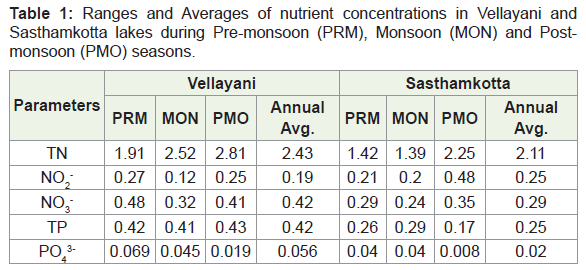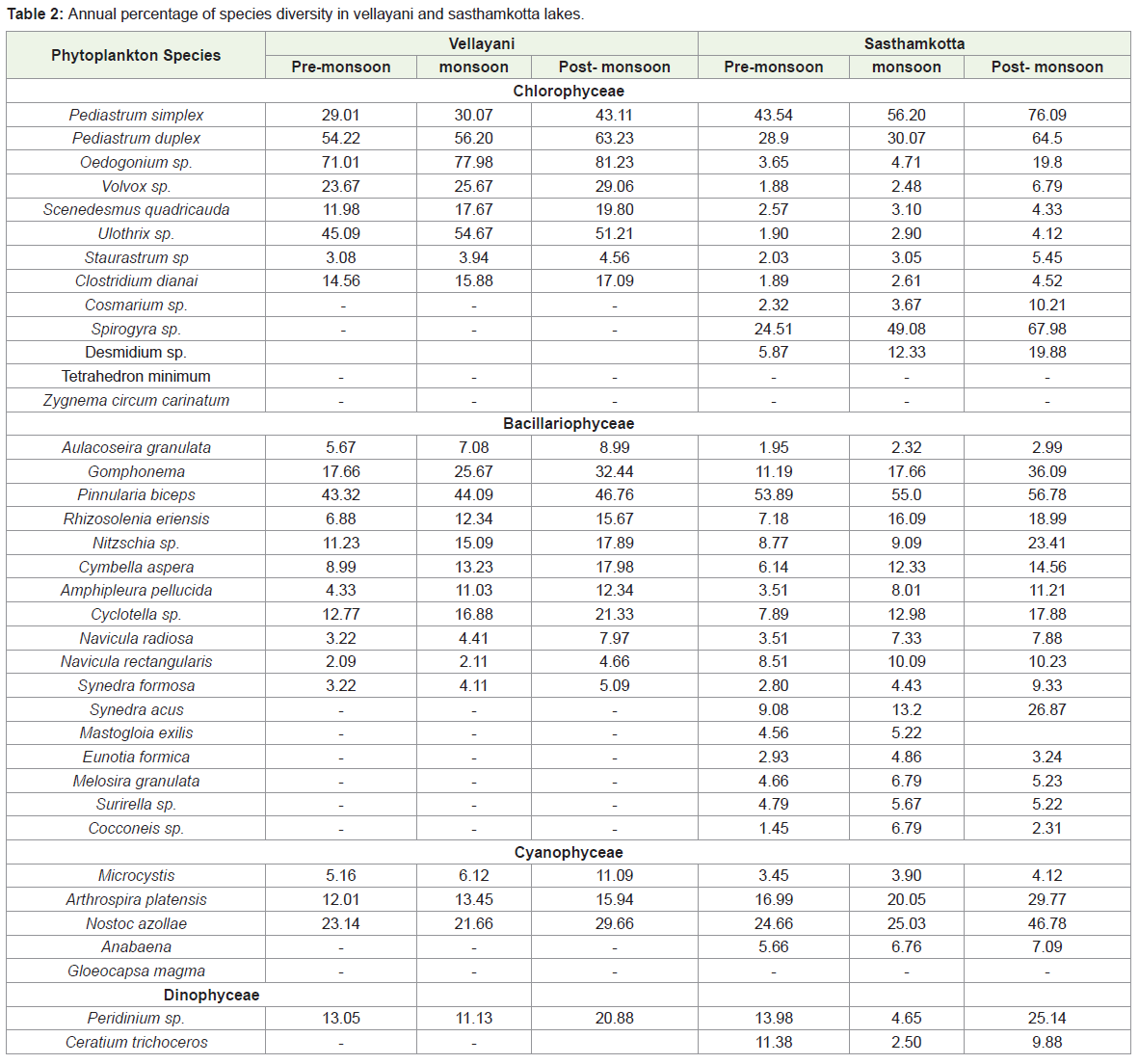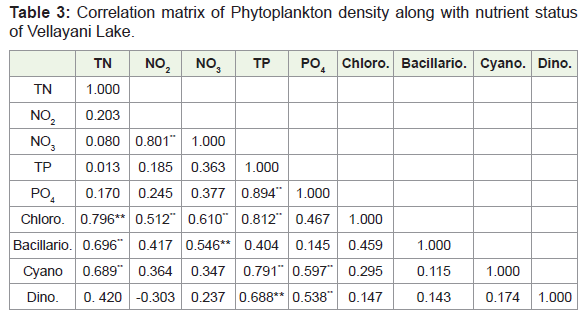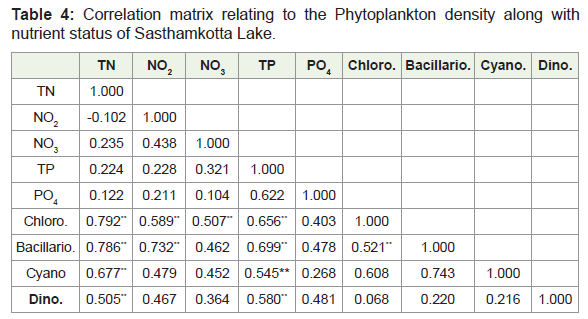Research Article
Evaluation of Phytoplankton Diversity and Environmental Implications of Two Lacustrine Wetlands, Located In Midland and Lowland Critical Zones of Kerala, India
Revathy D and Krishnakumar A*
ESSO-National Centre for Earth Science Studies (NCESS), Ministry of Earth Sciences, India
Corresponding author: Krishnakumar A, ESSO-National Centre for Earth Science Studies (NCESS), Ministry of Earth Sciences, Govt of India, Akkulam, Thiruvananthapuram-695011, Kerala, India, E-mail: drakrishnakumar@gmail.com
Citation: Revathy D, Krishnakumar A. Evaluation of Phytoplankton Diversity and Environmental Implications of Two Lacustrine Wetlands, Located In Midland and Lowland Critical Zones of Kerala, India. J Environ Soc Sci. 2018;5(1): 135
Copyright ©2018 Revathy D, et al. This is an open access article distributed under the Creative Commons Attribution License, which permits unrestricted use, distribution, and reproduction in any medium, provided the original work is properly cited.
Journal of Environmental and Social Sciences | Volume: 5, Issue: 1
Submission: 10/01/2018; Accepted: 28/02/2018; Published: 03/03/2018
Abstract
Current study was carried out to provide a better understanding on the species richness of phytoplankton community in two Freshwater lakes of Kerala, namely; Sasthamkotta and Vellayani located in the respective midland and lowland critical zones of Kerala, and their relationship with nutrient status. Samplings were conducted seasonally i.e., during pre-monsoon, monsoon and post monsoon seasons. Water samples were collected for nutrients analysis (TN, NO2-, NO3-, TP and PO43-) and phytoplankton counting. The investigations showed a total of forty-two phytoplankton genera, representative of four families were identified. The nutrient concentrations in the two lake ecosystems show higher values throughout the year and the phytoplankton community show species richness. In general, increase in nutrient concentration triggered the increased diversity of phytoplankton community. This was clearly evident from the correlation analysis, there was a significant positive relationship noticed between phytoplankton community with the nutrient concentrations.
Keywords:
Phytoplankton diversity; Nutrients; Freshwater lakes; Critical zone; Correlation analysis
Introduction
The sustenance of a healthy aquatic ecosystem depends on the physico-chemical and the biological diversity of the ecosystem [1]. Phytoplankton represents the microscopic algal communities which collectively accounted about half of the earth’s primary producers. They act as pioneers of aquatic food chain and the productivity of an aquatic system is directly related to diversity of phytoplankton. Anthropogenic discharges into the water bodies act as an important source of the nutrients that accelerate the growth of aquatic communities and further leads to the qualitative changes of the aquatic systems [2].
The present study has been carried out to estimate the phytoplankton diversity of two fresh water lakes of Kerala, namely, Sasthamkotta and Vellayani with special reference to nutrients levels. This type of study is highly significant in Kerala, since these lakes form the source of water for public distribution systems located in the respective midland and highland critical zones of the state.
Sasthamkotta lake, is the largest fresh water lake in Kerala, which was declared as a Ramsar site of International importance and it serves as the source of drinking water for half a million people at the Kollam corporation and panchayats adjust ant to the lake. Vellayani Lake, the second largest lake of the state, situated at the outskirts of Thiruvananthapuram City. This lake is extensively used for drinking as well as irrigational purposes.
Materials and Methods
Twenty water samples were collected seasonally (pre-monsoon, monsoon and post-monsoon) from Sasthamkotta and Vellayani lakes and the samples were analysed for various nutrients (TN, NO2-, NO3-, TP and PO43-) following APHA [3].
Phytoplankton samplings were also carried out according to the standard methods prescribed in APHA [3]. Approximately 20lit of water from each site was filtered using plankton net with a mesh size of 60µm. The collected samples were fixed with 4% Lugol’s solution. Taxonomic identification of plankton up to genus level was done using standard keys [4-7].
Results and Discussion
The various nutrients estimated in the lakes were depicted in terms of the ranges and averages (Table 1). The annual fluctuations of the percentage composition of the four major groups of phytoplankton community in Sasthamkotta and Vellayani lakes were given in (Table 2). Based on the data obtained through the analysis, correlation study was made to find out the interrelationship between the phytoplankton density and nutrient levels in both lakes (Table 3 and Table 4). The annual percentage composition showed that Chlorophyceae was the most dominant group (56.43%) observed in Vellayani Lake as reported earlier by Priya, et al. in the Vellayani Lake [8]. Remarkably, in Sasthamkotta Lake, the dominant group was Bacillariophyceae (41.85%) which was observed previously by Girija, et al. [9].
A comparative evaluation was made in both lakes in terms of species diversity. Of the total 42 genera identified in the two lakes, the highest percentage of composition was observed by Oedogonium sp. (81.23%) in Vellayani lake during post-monsoon season and the lowest percentage was by Cocconeis sp. (1.45%) in Sasthamkotta lake during pre-monsoon season. According to Dumont, the water body is regarded as rich, if it contains 30-50 species. In this sense, both the lakes can be treated as rich in terms of species diversity [10].
In both lakes, it was observed that phytoplankton was abundant during post-monsoon season and the least was observed during premonsoon seasons. The excessive flooding was the main causative factor for the presence of a low population of phytoplanktons during monsoon [11].
Correlation analysis of Chlorophyceae, Bacillariophyceae, Cyanophyceae and Dinophyceae with the nutrients (TN, NO2-, NO3-, TP and PO42-) of water samples from Vellayani Lake and Sasthamkotta Lake revealed that there existed a significant linkage between plankton community with nutrients, both in nitrogenous as well as phosphatic nutrients. It was very much clear from this study that the increased algal growth may be due to the increased level of nutrients. From field observations, it was noticed that artificial fish feeding due to integrated fish farming and the pesticide residues from the surrounding agricultural lands resulted in the accumulation of nutrients in the lake systems. The presence of Microcystis sp. in both lakes indicates the signs of nutrient enrichment.
Conclusion
In the present study efforts have been made to ascertain the seasonal abundance and population dynamics of phytoplankton community and its relationship with nutrients status of two tropical lakes, Vellayani and Sasthamkotta, Southern Kerala. Algal diversity shows that Chlorophyceae show dominance in Vellayani Lake whereas Bacillariophyceae forms their dominance in Sasthamkotta Lake. The study reveals that there is positive relationship between plankton biomass with nutrients and found that planktonic biomass is regulated by nutrients status in freshwater bodies.
Acknowledgements
The authors are grateful to the Director, NCESS for providing necessary facilities to do the work. One of the authors (RD) is thankful to University of Kerala for awarding JRF.
References
- Krishnan KH, Thomas S, George S, Murugan RP, Mundayoor S, et al. (1999) A study on the distribution and ecology of phytoplankton in the Kuttanad wetland ecosystem, Kerala. Poll Res 18: 261-269.
- Adolf JE, Yeager CL, Miller WD, Mallonee ME, Harding LW (2006) Environmental forcing of phytoplankton floral composition, biomass, and primary productivity in Chesapeake Bay, USA. Estuar Coast Shelf Sci 67: 108-122.
- APHA (2005) “Standard Methods for Examination of Water and Wastewater”. American Public Health Association WWA, Washington DC.
- Adoni A, Joshi DG, Gosh K, Chourasia SK, Vaishya AK, et al. (1985) Work book on limnology. Pratibha Publisher Sagar pp: 1-166.
- Newell GE, Newell RC (1986) Marine Plankton, a practical guide. Hutchinson and Co. Publishers Ltd, London 206.
- Palmer CM (1980) Significance of algae. In “Algae and water pollution” castle Home publications London.
- Santhanam R, Ramanathan N, Venkatara-manujam K, Jegatheesan G (1987) Phytoplankton of the Indian Seas. Daya publishing House, Delhi 134.
- Priya Gopinath T, Ajit Kumar KG (2014) A Study on the physico-chemical parameters and diversity of Phytoplankton in Vellayani Lake, Thiruvananthapuram, Kerala, India. Journal of Aquatic Biology and Fisheries 2: 489-492.
- Girijakumari S, Abraham NP (2007) Composition and distribution of phytoplankton in Sasthamkotta Lake, Kollam, Kerala. Indian Hydrobiology 10: 377-380.
- Dumont JE (1994) Zooplankton of the Niger System. In: Davies BR, Walker KH (eds). The Ecology of River Systems Monogr Biol 60: 49-59.
- Katari Bhaskar, Sunil Nautiyal, Imran Khan YD, Rajanna L (2015) A Preliminary Study on Phytoplankton in Fresh Water-Lake of Gogi, Yadgir District, Karnataka. IJIRSET 4: 2030-2037.




